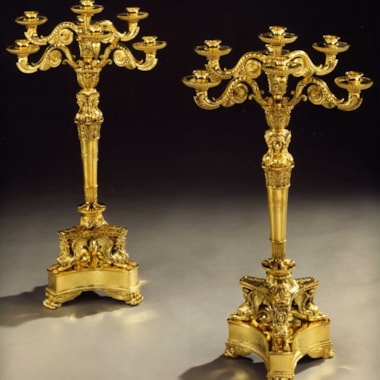The bell-shaped bowl divied by slender moulded rings, one with a delicate wire border, into three compartments. In the central one are three classical masks applied in relief on a background of linen festoons, birds and foliage. The stem is vase-shaped, worked in relief with masks and with three dolphin handles. The foot is spreading, in two tiers, and similarly decorated. The cover ornamented with nasks, escutcheons and fruit.
The vases, acanthus and strapwork which decorate the mounts of this cup and cover follow Italian Renaissance motifs popularized in England during the middle years of the sixteenth century by the prints of Hans Vriedemann de Vries, Cornelis Floris and other Flemish artists. This decoration in the latest Continental style, combined with the superb modelling and finish of the mounts, characterize the group of London silver marked with a bird in a shaped shield.
Sir Charles Jackson had attributed this mark to Thomas Bampton on account of his shop sign, The Falcon, but a much more likely candidate is Affabel Partridge who, according to Timothy Schroder, served as Royal Goldsmith to both Mary I and Elizabeth I.[1] Schroder has recorded some twenty items bearing this mark, ranging in date from 1554 to 1579, including a number of mounted pieces.[2] Some twenty years ago Arthur Grimwade identified the worn maker’s mark on Queen Elizabeth’s Salt of 1572 in the Tower of London as being that of Partridge, and drew comparisons with the panels of the Virtues which decorate the body of that salt with similar panels on the salt of 1569 belonging to the Vintners’ Company, also with Partridge’s mark[3]. The meticulous finish of the cast heads that adorn the salt should be compared with the modelling and chasing of the heads on the stem of this cup and cover.
Grimwade surmised that much of Partridge’s output may be the work of Flemish or German craftsmen working in Partridge’s London workshop.[4] The cosmopolitan nature of Partridge’s business is illustrated by the three gilt salts “of the French making” which he supplied to the Royal Household in the late 1570s.[5] Much of Partridge’s work is characterised by superb engraving. The set of twelve spice plates of 1567 engraved with scenes of the Labours of Hercules, in the Fowler Collection at UCLA, California, bears his mark; the engraving on three of the set is also signed by the monogrammist P over M who was responsible for some of the most ambitious engraving on silver sold in England during the third quarter of the sixteenth century.[6]
Partridge served as Warden of the Goldsmiths’ Company and occupied shop premises owned by the Company, probably in Cheapside. In 1569 “Mr Warden Partiche [was] bound in £10 to deliver yearly, during his life, one buck of season in consideration of receiving a grant of his lease”.[7] Partidge is without doubt the “Master Partidge” in whose house Lady Jane Grey lodged in 1553 prior to being proclaimed queen.[8] Partridge’s mark appears on the two surviving Bacon Cups, of 1572, made for Sir Nicholas Bacon,[9] and the Lambarde Cup of 1578 belonging to the Drapers’ Company.[10] It is clear, therefore, that he was a goldsmith at the heart of both economic and social spheres.
[1] T. Schroder, Renaissance Silver from the Schroder Collection, The Wallace Collection, London, 2007, p. 139.
[2] See T. Schroder, The Gilbert Collection of Gold and Silver, Los Angeles County Museum of Art, 1988, p. 53; an updated list of fifteen pieces, based on Schroder’s researches, appears in Grimwade, “The Silver Plate”, in C. Blair, ed., The Crown Jewels, The History of the Coronation Regalia in the Jewel House of the Tower of London, The Stationery Office, London, 1998, no. 1.
[3] S. Lee, The Worshipful Company of Vintners, A Catalogue of Plate, London, 1996, p. 24.
[4] A. Grimwade, op. cit., no. 1.
[5] P. Glanville, Silver in Tudor and Early Stuart England, Victoria & Albert Museum, London, 1990, p. 110.
[6]
[7] Sir W.S. Prideaux, Memorials of the Goldsmiths’ Company, London, 1891, p. 70.
[8] BL Harleian MSS. no. 194
[9] One in the British Museum, the other formerly in the Victoria & Albert Museum, now in the Ashmolean Museum.
[10] M.A. Greenwood, The Ancient Plate of the Drapers’ Company with Some Account of its Origin, History and Vicissitudes, London, 1930, p. 13.
T.W. Waller, dec’d, sale, Christie’s, London, June 7, 1910, J. Pierpont Morgan, by descent until 2010
J. Starkie Gardner, ed., Exhibition of a Collection of Silversmiths’ Work of European Origin, exh. cat., Burlington Fine Arts Club, London, 1901, no. 5, Case B, p. 10
You May Also Like









































































